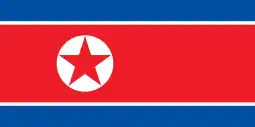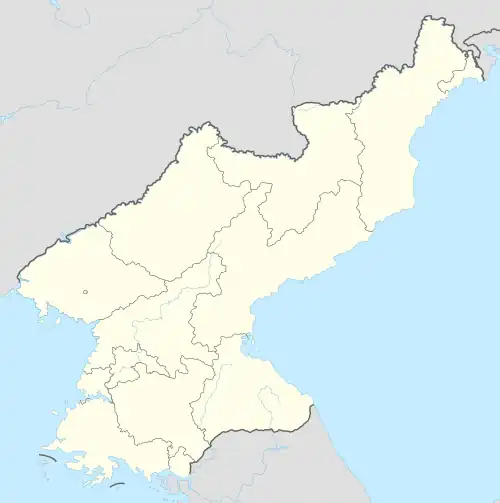| Kaechon internment camp | |
| Chosŏn'gŭl | 개천 제14호 관리소 |
|---|---|
| Hancha | |
| Revised Romanization | Gaecheon Je14ho Gwalliso |
| McCune–Reischauer | Kaechŏn Che14ho Kwalliso |
| Chosŏn'gŭl | 개천 정치범수용소 |
| Hancha | |
| Revised Romanization | Gaecheon Jeongchibeom Suyongso |
| McCune–Reischauer | Kaechŏn Chŏngch'ibŏm Suyongso |
| Part of a series on |
| Human rights in North Korea |
|---|
 |
Kaechon Internment Camp (Hangeul: 개천 제14호 관리소, also spelled Kae'chŏn or Gaecheon) is a labor camp in North Korea for political prisoners and descendants of alleged criminals. The official name for the camp is Kwan-li-so (Penal-labor colony) No. 14. The camp is commonly known as Camp 14. It is not to be confused with the Kaechon concentration camp (Kyo-hwa-so No. 1), which is located 20 km (12 mi) to the northwest. Nearest train station is the Oedong station of the Taegon Line.
Description

The camp was established around 1959[1] in central North Korea near Kae'chŏn county, South Pyongan Province. It is situated along the middle reaches of the Taedong river, which forms the southern boundary of the camp, and includes the mountains north of the river, including Purok-san. Bukchang, a concentration camp (Kwan-li-so No.18) adjoins the southern banks of the Taedong River. The camp is about 155 km2 (60 sq mi) in area, with farms, mines, and factories threaded through the steep mountain valleys.[2][3][4] The camp includes overcrowded barracks that house males, females, and older children separately, a headquarters with administrative buildings, and guard housing.[5] Altogether around 15,000 are imprisoned in Kaechon internment camp.[6]
Purpose
The main purpose of the Kaechon internment camp is to keep politically unreliable individuals classed "unredeemable" by the North Korean government[1] isolated from society and to exploit their labour.[7] Those sent to the camp include officials perceived to have performed poorly in their job, people who criticize the regime, their children, anyone who was born in the camp, and anyone suspected of engaging in "anti-government" activities.[8] Prisoners have to work in one of the coal mines, in agriculture, or in one of the factories that produce textiles, paper, food, rubber, shoes, ceramics, and cement. Livestock raising is considered the occupation of choice for the prisoners as it gives them the chance to steal animal food and pick through animal droppings for undigested grains.[6]
Human rights situation
Witnesses have reported that prisoners interred in the camp are required to work for long periods, often from 5:30 to midnight.[9] Even 11-year-old children have to work after school and thus rarely see their parents.[10] Other reports describe prisoners being beaten and severely punished for minor infractions.[11][12]
Food rations are scant, consisting of salted cabbage and corn. The prisoners are emaciated; they lose their teeth, and their gums blacken.[4] Many die of malnourishment, illness, work accidents, and the after-effects of torture. Many prisoners resort to eating frogs, insects, rats, snakes, and even cannibalism in order to try to survive.[1][11] Eating rat flesh helps prevent pellagra, a common disease in the camp resulting from the absence of protein and niacin in the diet. In order to eat anything outside of the prison-sanctioned meal, including these animals, prisoners must first get permission from the guards.[1]
Imprisoned witnesses
Shin Dong-hyuk
In his official biography Escape from Camp 14 by Blaine Harden, Shin Dong-hyuk claimed that he was born in the camp and lived there until escaping in his early twenties. In 2015, Shin recanted some of this story.[13] Shin told Harden that he had changed some dates and locations and incorporated some "fictive elements" into his account. Harden outlined these revisions in a new foreword but did not revise the entire book. Shin said that he did not spend his entire North Korean life at Camp 14. Though maintaining that he was born there, he stated that, when he was young, his family was transferred to the less severe Camp 18, and spent several years there. He said that he was tortured in Camp 14 in 2002, as punishment for escaping from Camp 18.[14][15]
Kim Yong
Kim Yong (1995–1996 in Kaechon, then in Bukchang) was imprisoned after it was revealed that the two men who were executed as alleged US spies were his father and brother.[6] He witnessed approximately 25 executions in his section of the camp within less than two years.[16]
See also
References
- 1 2 3 4 Blaine Harden (16 March 2012). "How one man escaped from a North Korean prison camp". The Guardian. Archived from the original on May 9, 2012. Retrieved 4 February 2013.
- ↑ "Committee for Human Rights in North Korea: Satellite Imagery of the North Korean Gulag: Kwan-li-so No. 14 Kaechon Overview, p. 209" (PDF). Retrieved 2012-12-07.
- ↑ North Korean Human Rights: Prison Camps in 2012..., ned.org; accessed October 30, 2014.
- 1 2 Harden, Blaine (July 20, 2009). "N. Korea's Hard-Labor Camps: On the Diplomatic Back Burner". The Washington Post.
- ↑ "Committee for Human Rights in North Korea: Satellite Imagery of the North Korean Gulag: Kwan-li-so No. 14 Kaechon Headquarters" (PDF). p. 211. Retrieved 2012-12-07.
- 1 2 3 "Committee for Human Rights in North Korea: The Hidden Gulag (Section: Testimony Kwan-li-so No. 14 Kaechon, p. 48)" (PDF). Retrieved 2012-12-07.
- ↑ "Prison Camps of North Korea - Camp 14 Kaechon", U.S. State Department Bureau of Democracy, Human Rights and Labor, archived from the original on May 14, 2015, retrieved January 15, 2015
- ↑ "End horror of North Korean political prison camps". Amnesty International. May 4, 2011. Retrieved January 15, 2014.
- ↑ Yang Jung A (2007-07-03). "My Mother is Executed. Yet I am not sad". Daily NK. Retrieved 2012-12-10.
- ↑ Sang-Hun, Choe (July 9, 2007). "Born and raised in a North Korean gulag". The New York Times.
- 1 2 Anderson Cooper (February 18, 2014). "UN witness describes horrors of North Korea (Anderson Cooper's remarkable interview with Shin Dong-hyuk, who was born in "Camp 14", a North Korean gulag described in a UN Human Rights report)". 60 Minutes Overtime.
- ↑ Shin Dong-Hyuk (December 1, 2008). ""A Glimpse of Horror", Radio Free Asia". Rfa.org. Retrieved 2012-12-07.
- ↑ Anna Fifield (17 January 2015). "Prominent N. Korean defector Shin Dong-hyuk admits parts of story are inaccurate". Washington Post.
- ↑ Harden, Blaine (2015). "A new Foreword to Escape from Camp 14". blaineharden.com.
- ↑ John Power (March 18, 2015). "Author of book on North Korea's founding addresses Shin controversy". NK News.
- ↑ "The Hidden Gulag – Exposing Crimes against Humanity in North Korea's Vast Prison System (pp. 51-52)" (PDF). The Committee for Human Rights in North Korea. Retrieved April 25, 2012.
Further reading
- Blaine Harden (March 29, 2012). Escape from Camp 14: One Man's Remarkable Odyssey from North Korea to Freedom in the West (HC (hardcover)). Viking. ISBN 978-0670023325.
External links
- United Nations Office of the High Commissioner for Human Rights – Report of the Commission of Inquiry on Human Rights in the Democratic People's Republic of Korea
- North Korea: Political Prison Camps - Amnesty International document on conditions in North Korean prison camps (May 2011).
- "Committee for Human Rights in North Korea – Overview on North Korean Prison Camps with Testimonies and Satellite Photographs" (PDF). HRNK.org.
- "Life Funds for North Korean Refugees (NGO): Political prisoner Shin Dong-hyuk tells about his life in the camp". NorthKoreanRefugees.com. September 2007.
- "Born and raised in a North Korean gulag". New York Times. July 7, 2007.
- "Escapee Tells of Horrors in North Korean Prison Camp". Washington Post. December 11, 2008.
- "Citizens' Alliance for North Korean Human Rights". Eng.NKHumanRights.or.kr. Witness accounts by North Korean refugees
- "Escape from 'Total Control Zone' - North Korea's Papillon". The Daily NK. May 11, 2007. Archived from the original on July 16, 2011. Retrieved April 15, 2010.
- "One Free Korea: Camps 14 and 18, North Korea: Satellite Imagery". FreeKorea.us. Detailed satellite images with comprehensive explanations